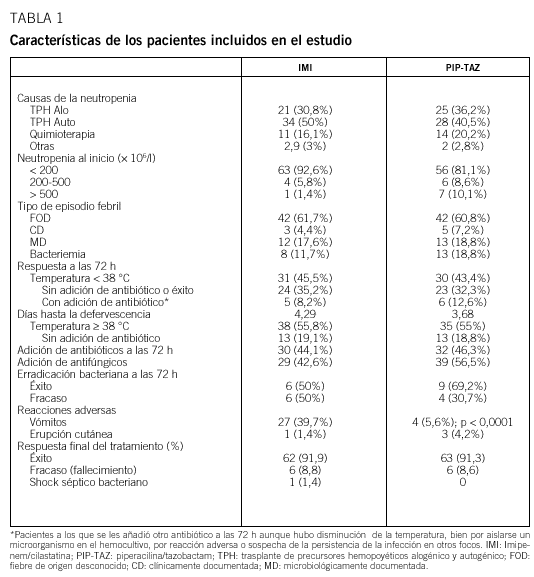Fundamento: La monoterapia antibiótica de amplio espectro es una práctica aceptada hoy día para el tratamiento empírico inicial de la neutropenia febril. Existe una amplia experiencia con el uso de imipenem (IMI). La piperacilina-tazobactam (PIP-TAZ) es un agente de desarrollo más reciente, que ofrece un espectro similar, y sobre el que existe menos experiencia como agente único, no asociado a un aminoglucósido.
Pacientes y método: Se aplicó una estrategia secuencial de adición antibiótica si a las 72 h persistía la fiebre o se aislaban microorganismos, y cobertura antifúngica si a los 5-7 días persistía fiebre no documentada.
Resultados: Se evaluaron 137 pacientes obteniendo un porcentaje de éxito a las 72 h con PIP-TAZ similar al de IMI (32,2 y 35,2%, respectivamente). El tiempo de defervescencia con PIP-TAZ fue menor que con IMI (3,6 y 4,2 días, respectivamente), y mayor la erradicación bacteriana (el 69,2 y el 50%; p = NS). La respuesta clínica final en ambos grupos fue del 91%. El 18,2% de los episodios fueron bacteriológicamente documentados. El microorganismo más frecuente fue Staphylococcus coagulasa negativo (48,8%). Sólo hubo un caso de shock séptico con IMI, y la mortalidad global del grupo fue del 8,7%. Destaca la significativa mayor frecuencia de vómitos con IMI que con PIP-TAZ (el 39,9 frente al 5,6%; p < 0,0001).
Conclusiones: La eficacia de PIP-TAZ fue equivalente a la de IMI, por lo que constituye una buena opción como monoterapia empírica inicial de los episodios de neutropenia febril.
Background: We aimed at comparing the effectiveness and safety of piperacillin/tazobactam (PIP-TAZ) versus imipenem/cilastin (IMI) administered as empiric monotherapy in patients with febrile neutropenia.
Patients and method: Patients with hematological diseases who were randomly assigned either PIP-TAZ or IMI were enrolled in the study. A sequential strategy of antibiotic therapy addition was applied as long as fever persisted or microorganisms were isolated at 72 h. Moreover, if bacteriologically unconfirmed fever persisted after 5-7 days, an antifungal therapy was started. The treatment was considered successful if fever and clinical signs resolved and/or pathogens were cleared without adding further antibiotics at 72 h. Differences between percentages were analyzed using the *2 test.
Results: 137 patients were evaluated. The successful response rate of PIP-TAZ after 72 h was similar to IMI (32.2 and 35.2%). The defervescence time was shorter (3.6 and 4.2 days) and the bacterial response more favourable with PIP-TAZ than with IMI, but statistically significant differences were not reached. The overall response in both groups was 91%. 18.2% of episodes were bacteriologically confirmed. The most frequent isolated microorganism was Staphylococcus coagulase-negative (48.8%). There was one only case of septic shock, within the IMI group, and the overall mortality of the group was 8.7%. The occurrence of vomiting in the IMI group was significantly higher than in the PIP-TAZ group (39.9 and 5.6%; p < 0.0001).
Conclusions: PIP-TAZ is as effective as IMI and it constitutes a good choice as an initial empiric monotherapy of febrile neutropenia.
Artículo
Comprando el artículo el PDF del mismo podrá ser descargado
Precio 19,34 €
Comprar ahora







